Microsoft’s second attempt at its interesting dual-screen Android smartphone corrects some mistakes of the original, but falls short of a revolution due to a series of oddities created by its physical laptop-like form.
Looking more like a tiny convertible computer than a phone, the Surface Duo 2 starts at £1,349 ($1,499/A$2,319), a lot for a regular smartphone but slightly cheaper than folding-screen rivals.
It opens like a book, with each half just 5.5mm thick, and a hinge that allows it to fold all the way over.

Inside are a pair of 90Hz OLED screens each measuring 5.8in on the diagonal. They can be used on their own or combined as one display measuring 8.3in – a similar size to an iPad mini. Both screens are covered in traditional scratch-resistant smartphone glass and have large, old-fashioned bezels top and bottom.
Having two separate displays rather than one that folds in half creates a major drawback: a gap in the middle of the screen big enough that you can see through it, which is much harder to ignore than the crease in the middle of a flexible display as found on the Samsung Galaxy Z Fold 3.
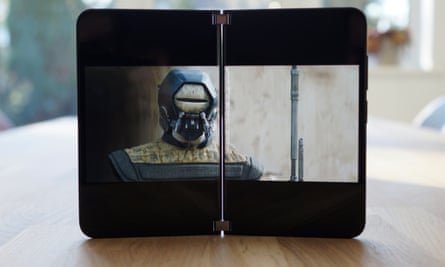
You can use two different apps at the same time on the two screens. The theory is sound, but I found few pairings were useful beyond simple messaging apps and a browser. More useful was using one screen for a note-taking app and the other for a full keyboard like a mini laptop.
Some apps spanned across both displays, like Outlook, can put different information on each screen, such as your inbox on one side and an open message on the other. Some games, including Asphalt 9 and Microsoft’s Xbox Game Pass streaming service, put controls on one screen and the action on the other. But there are very few apps and games optimised for this setup.

Specifications
Screens: two 5.8in AMOLED 90Hz displays
Processor: Qualcomm Snapdragon 888
RAM: 8GB of RAM
Storage: 128, 256 or 512GB
Operating system: Android 11
Cameras: 12MP wide, 16MP ultra-wide, 12MP 2x telephoto; 12MP selfie
Connectivity: 5G, USB-C, wifi 6, NFC, Bluetooth 5.1 and location
Water resistance: IPX1 (dripping water)
Dimensions closed: 145.2 x 92.1 x 11.0mm
Dimensions open: 145.2 x 184.5 x 5.5mm
Weight: 284g
2021’s top Android chip
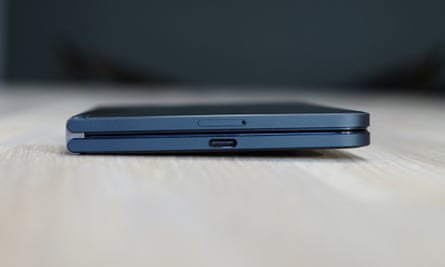
The Duo 2 has last year’s top Qualcomm Snapdragon 888 chip with 8GB of RAM, matching the performance of top-flight Android smartphones from 2021 and capable of running two apps running side-by-side without slowdown.
Battery life is more variable than a traditional phone. It lasts about 32 hours between charges, with both screens used for about four hours with a variety of messaging, browsing and work apps. It lasts about a third longer if you mostly use only one screen. That’s a considerably shorter battery life than a regular smartphone and behind the Z Fold 3.
Sustainability
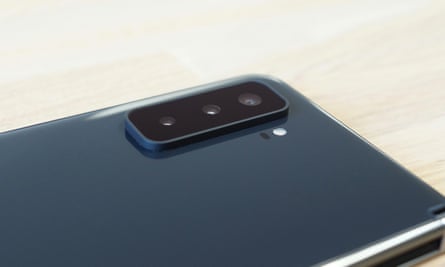
Microsoft does not provide an expected lifespan for the Duo 2’s battery; those in similar devices typically maintain at least 80% of their original capacity for in excess of 500 full charge cycles. Microsoft charges an out-of-warranty service fee of £593.94 to repair devices and £568.44 to replace the battery. The previous generation Surface Duo scored only two out of 10 on iFixit’s repairability scale.
The phone contains no recycled materials, but Microsoft operates recycling schemes for old devices, publishes a company-wide sustainability report and a breakdown of each product’s environmental impact.
Android 11

The Duo 2 runs Android 11 – not the latest Android 12 – and generally behaves like a standard Android smartphone or tablet with a few small additions that make it easier to use each screen separately. One of the best is the ability to drag the gesture bar at the bottom of an app to move it between screens or to drop it on to the gap between the screens to span it across both displays.
The software can be a bit unpredictable at times, such as opening the keyboard or text box of an app on another screen or hiding a second app from the screen when you try to type. But it is generally a fast and responsive experience given how unusual the device is.
The Duo 2 will receive three years of software updates from release, including monthly security patches, which is disappointingly at least a year short of what rivals, including Samsung and Apple, offer. Microsoft’s last planned update for the Duo 2 will be 21 October 2024.
Camera
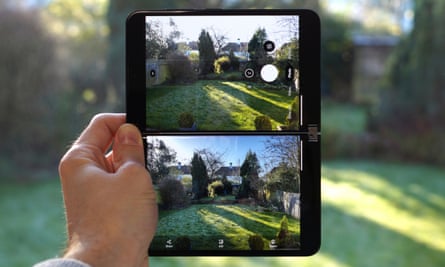
The Duo 2 has a triple camera on the back and a 12-megapixel selfie camera above the right-hand screen.
The rear main 12MP camera and 2x telephoto cameras are good, capable of producing detailed shots in a range of lighting conditions. The 16MP ultra-wide camera is reasonable, but a bit soft on detail and struggles with challenging scenes. The camera app has most of the features you’d expect, such as portrait mode, night mode and slow-mo video, and can shoot regular video at up to 4K at 60 frames a second.
The 12MP selfie camera is capable of shooting detailed photos even in middling light, and has access to the dedicated night mode when it gets dark.
Overall, the camera system on the Duo 2 is solid, but it can’t hold a candle to the best in the business.
Observations
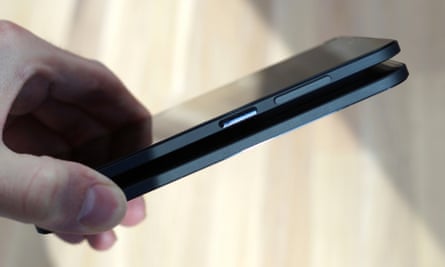
The Duo 2 supports Microsoft’s Slim Pen stylus, which can be magnetically stored and charged on the back of the device when not in use.
The stereo speakers are decently loud but a bit tinny, fine for watching YouTube videos.
The width of the device makes it a challenge to fit into smaller pockets.
Price
The Surface Duo 2 costs £1,349 ($1,499/A$2,319) with 128GB, £1,429 ($1,599/A$2,469) with 256GB or £1,589 ($1,799/A$2,769) with 512GB of storage.
For comparison, the Samsung Galaxy Z Fold 3 costs £1,599 and the Galaxy Z Flip 3 costs £949.
Verdict
The Surface Duo 2 is an improvement on its predecessor, but is still a very odd proposition that’s neither a good phone nor a good tablet.
The individual screens are short and stout, forcing lots of scrolling in apps when using it like a phone and making one-handed use very difficult. The gap at the hinge makes combining them into one big tablet screen awkward too.
Using two apps side-by-side works well, but few combinations proved useful or faster than just quick switching between two apps on one screen on a normal phone. There is more potential in apps like Outlook that provide a multi-pane view, but few apps or games are optimised for the dual-screen system.
Microsoft is only offering a disappointing three years of software and security updates from release for the Duo 2, too, losing it a star.
It is good to see Microsoft trying something different. But ultimately the Duo 2’s two screens are just not yet as good or useful as either a single phone screen or a bigger folding screen, making it an expensive halfway house.
Pros: two screens, two apps side-by-side, multiple modes, top performance, hardened glass screens, decent camera, head-turning design.
Cons: gap between screens, few optimised apps, average battery life, bulky camera lump, chunky in pocket, hard to use one-handed, no real water resistance, only three years of software updates from release.

Other reviews
Galaxy Z Fold 3 review: Samsung’s cutting-edge water resistant phone-tablet hybrid
Galaxy Z Flip 3 review: Samsung’s cheaper, better hi-tech flip phone
Apple iPad mini 2021 review: the best small tablet gets stunning revamp
Surface Pro 8 review: Microsoft’s best Windows tablet gets big upgrade
Microsoft Surface Go 3 review: small Windows 11 tablet can’t keep up
